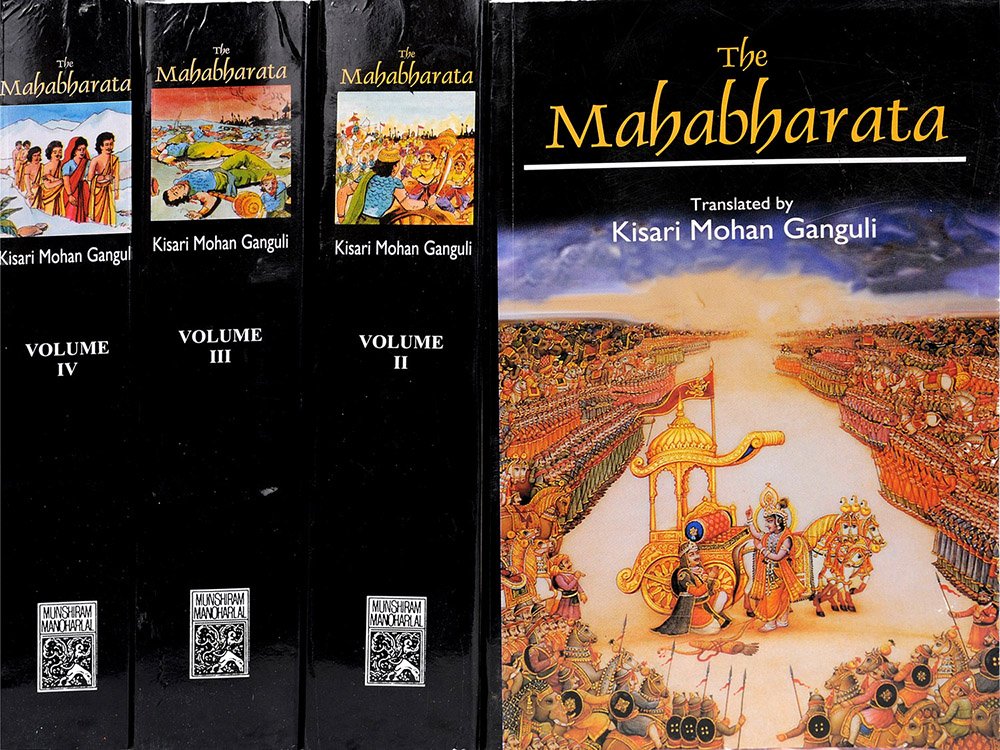Mahabharata (English)
by Kisari Mohan Ganguli | 2,566,952 words | ISBN-10: 8121505933
The English translation of the Mahabharata is a large text describing ancient India. It is authored by Krishna-Dwaipayana Vyasa and contains the records of ancient humans. Also, it documents the fate of the Kauravas and the Pandavas family. Another part of the large contents, deal with many philosophical dialogues such as the goals of life. Book...
Section IV
Vaisampayana said,—"Having said these words unto Dhritarashtra, Vyasa took his departure. And Dhritarashtra also, having heard those words, began to reflect in silence. And having reflected for only a short space of time, he began to sigh repeatedly.
And, soon, O bull of Bharata’s race, the king asked Sanjaya of soul worthy of praise,—saying,—
'O Sanjaya, these kings, these lords of earth, so brave and taking delight in battle, are for smiting one another with weapons of diverse kinds, being prepared to lay down their very lives for the sake of earth. Incapable of being restrained, they are, indeed, smiting one another for increasing the population of Yama’s domain. Desirous of prosperity connected with the possession of earth they are incapable of bearing one another. I, therefore, think that earth must be possessed of many attributes. Tell me all these, O Sanjaya, Many thousands, many millions, many tens of millions, many hundreds of millions, heroic men have come together at Kurujangala. I desire to hear, O Sanjaya, with accurate details, about the situation and dimensions of those countries and cities from which they have come. Through the potency of that regenerate Rishi Vyasa of immeasurable energy, you are endued with the lamp of celestial perception and the eye of knowledge.
"Sanjaya said,—
'O you of great wisdom, I will recount to you the merits of earth according to my knowledge. Behold them with your eye of wisdom. I bow to you, O bull of Bharata’s race. Creatures in this world are of two kinds, mobile and immobile. Mobile creatures are of three kinds according to their birth, viz., oviparous, viviparous, and those engendered by heat and damp. Of mobile creatures, O king, the foremost are certainly those called viviparous. Of viviparous creatures the foremost are men and animals.
Animals, O king, of diverse forms, are of fourteen species. Seven have their abodes in the woods, and seven of these are domestic. Lions, tigers, boars, buffaloes, and elephants as also bears and apes, are, O king, regarded as wild. Kine, goats, sheep, men, horses, mules, and asses,—these seven amongst animals are reckoned as domestic by the learned. These fourteen, O king, complete the tale of domestic and wild animals, mentioned, O lord of earth, in the Vedas, and on which the sacrifices rest. Of creatures that are domestic, men are foremost, while lions are the foremost of those that have their abode in the woods. All creatures support their life by living upon one another. Vegetables are said to be immobile, and they are of four species viz., trees, shrubs, creepers, creeping plants existing for only a year, and all stemless plants of the grass species.[1]
Of mobile and immobile creatures, there are thus one less twenty; and as regards their universal constituents, there are five. Twenty-four in all, these are described as Gayatri (Brahma) as is well-known to all.[2] He who knows these truly to be the sacred Gayatri possessed of every virtue, is not liable, O best of the Bharatas, to destruction in this world. Everything springs from the earth and everything, when destroyed, merges into the Earth. The Earth is the stay and refuge of all creatures, and the Earth is eternal. He that has the Earth, has the entire universe with its mobile and immobile population. It is for this that longing for (the possession of the) Earth, kings slay one another.'"
Footnotes and references:
[1]:
Nilakantha explains these five species thus: trees such as the peepul; gulma (shrub), as kusa, kasa, &c., growing from a clump underneath; creepers, such as all plants growing upon the soil but requiring some support to twine round; Valli, those that creep on the earth and live for a year only, such, as the gourd, the pumpkin, etc., and lastly, Trina, such as grass and all plants that are stemless, having only their barks and leaves.
[2]:
When Gayatri, or Brahma or the Universe, is mentioned, these twenty-four are indicated, five of which exist independently, the remaining nineteen being the result of five in those various proportions.
Conclusion:
This concludes Section IV of Book 6 (Bhishma Parva) of the Mahabharata, of which an English translation is presented on this page. This book is famous as one of the Itihasa, similair in content to the eighteen Puranas. Book 6 is one of the eighteen books comprising roughly 100,000 Sanskrit metrical verses.
FAQ (frequently asked questions):
Which keywords occur in Section IV of Book 6 of the Mahabharata?
The most relevant definitions are: Sanjaya, Bharata, Dhritarashtra, Vyasa, Gayatri, Vaisampayana; since these occur the most in Book 6, Section IV. There are a total of 12 unique keywords found in this section mentioned 21 times.
What is the name of the Parva containing Section IV of Book 6?
Section IV is part of the Jambukhanda Nirmana Parva which itself is a sub-section of Book 6 (Bhishma Parva). The Jambukhanda Nirmana Parva contains a total of 10 sections while Book 6 contains a total of 3 such Parvas.
Can I buy a print edition of Section IV as contained in Book 6?
Yes! The print edition of the Mahabharata contains the English translation of Section IV of Book 6 and can be bought on the main page. The author is Kisari Mohan Ganguli and the latest edition (including Section IV) is from 2012.
